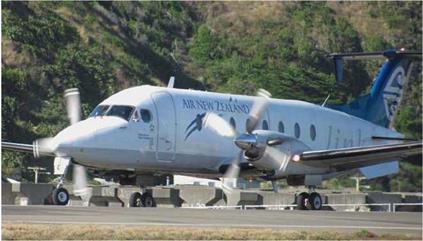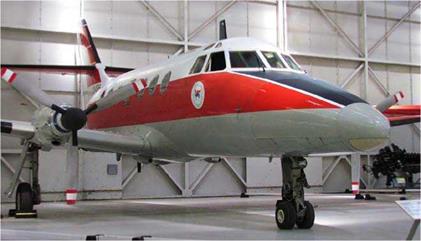Turboprops, Propulsors & Propfans
Turboprops
Turboprops are of two different types, the free-turbine and the fixed-shaft. The fixed-shaft is also known as single-shaft or direct-drive. This type of engine has its compressor/turbine mounted on the same shaft as the propeller. The other type of turbine is the free-turbine where the compressor/turbine is mounted on its own shaft separate from the prop shaft. It supplies a flow of exhaust gas pressure to the power turbine attached to the prop shaft. There is no direct mechanical link between the power turbine and the gas generator, hence the name of free-turbine. A very good example of this type of engine is the well-known Pratt & Whitney PT6A, which in its various versions powers three quarters of the light turbine fleet in the Western world.
The turboprop engine, whether it is fixed-shaft or free – turbine, works on the same principle as the jet engine, where
|
The Beech 1900D commuter airliner has two PT6A-67 free – shaft turboprop engines rated at 1279 SHP each. |
most of its heat energy is converted to shaft horsepower by the turbine. As opposed to the turbojet or turbofan which ejects a small volume of air rearwards at high velocity to generate thrust, the turboprop imparts a low velocity to a large mass of air via the propeller. The turboprop therefore, has higher propulsive efficiency than the turbojet at relatively lower air speeds, especially on take-off. The exhaust on some turboprops also ejects a small amount of jet thrust and when this is added to the shaft horsepower (SHP) available from the propeller, it is then termed equivalent shaft horsepower (ESHP). The prop thrust produced with the engine idling whilst taxiing can be more than sufficient and to warrant the use of frequent brake application or beta mode. To alleviate this problem, the constant speed unit may have a ground fine/ flat pitch stop to reduce the blade’s angle of attack to a value less than that of the normal fine/flat pitch stop setting, thereby reducing thrust.
|
The Scottish Aviation Jetstream 1 is powered by twin Turbomeca Astazou fixed-shaft turboprop engines. This aircraft is located in the RAF Museum Cosford, England. |
The two different types of turboprop engines require a slightly different approach in handling on the part of the pilot. The free-shaft turboprop is operated in a similar way to the piston-engine where the thrust lever (throttle) controls the compressor speed of the gas generator, while the prop RPM and hence the power absorption, is controlled by the propeller pitch lever. Propeller RPM (N1) and compressor speed (N2) are therefore both controlled independently of each other Because the compressor turns at a very high speed of around 15,000 RPM or more, a reduction gear is installed to drive the prop at a more sedate speed of 1000-2000 RPM. With the propeller and power turbine separated from the compressor, propeller inertia does not retard the very high acceleration possible with the free-turbine. Although the free-shaft engine has three engine controls, (the third is the condition lever or fuel control) compared to only two controls for the fixed-shaft engine, the free-shaft is a much easier engine for the pilot to operate
Power output on the fixed-shaft engine is controlled by either adjusting the fuel flow or by varying the compressor RPM and power absorption via the propeller pitch and thus the airflow through the engine. Fuel flow control and the constant-speed unit’s selection of blade angle to maintain RPM are interlocked to avoid compressor surge or over temping the engine. A low RPM and high fuel flow will cause an over rich fuel/air ratio, virtually flooding the engine. The engine operates at a very high RPM throughout all flight regimes and due to the narrow RPM range between flight-idle and maximum RPM, a high increase in power will require a rapid change in the blade angle. An engine failure on a fixed-shaft turboprop is far more serious than it is for a free-turbine. This is especially so during the approach when the prop blade is at a low angle of attack (fine/flat pitch) because the prop will absorb the large power required by the compressor. An auto-feathering device is required to turn the blades to the feathered position at as high a rate as possible.













